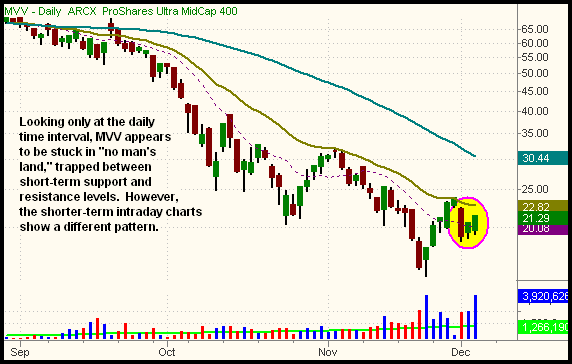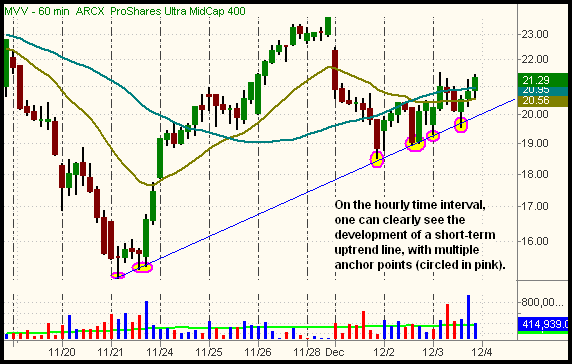|
The Wagner Daily ETF Report For December 4
Following a similar intraday pattern as the previous day, stocks became caught in a tug-of-war between the bulls and bears, but the bulls won again. After opening several percent lower, buyers lifted the major indices well into positive territory by mid-day, but an early afternoon sell-off caused stocks to fall back into firmly negative territory. Then, as with Tuesday's session, the bulls returned in the final ninety minutes of trading, propelling the main stock market indexes back to their best levels of the day. The Nasdaq Composite rose 2.9%, the S&P 500 2.6%, and the Dow Jones Industrial Average 2.1%. Trading in sync with their large-cap brethrens for a change, the small-cap Russell 2000 and S&P Midcap 400 indices gained 2.7% and 2.5% respectively. The major indices again finished near their best levels of the day.
Turnover ticked slightly higher across the board, enabling the S&P 500 and Nasdaq Composite to score their second straight "accumulation days." Total volume in the NYSE rose 2% above the previous day's level, while volume in the Nasdaq increased 11%. When stocks rise on increasing volume, it's a positive sign that mutual funds, hedge funds, pension funds, and other big money players are accumulating shares of stock. Still, because volume in both exchanges failed to move above 50-day average levels, institutions were not exactly making a mad dash for the "buy" button. Market internals were healthy, not overly extreme. In both the NYSE and Nasdaq, advancing volume exceeded declining volume by a margin of approximately 3 to 1.
If you've followed the broad market's intraday price action over the past two days, it's undoubtedly been indecisive and a bit whippy. However, a more subtle observation is the rare show of resilience stocks have displayed in each of the past two sessions. Throughout October and November, there were many days in which stocks rallied in the early afternoon, then nosedived into the close. But in each of the past two days, the broad market has displayed the inverse pattern. Further, despite the large sell-off of December 1, keep in mind the S&P and Dow have closed higher in seven of the last eight sessions. While it's still too early to know whether the recent rally attempt will get legs, astute traders may be noticing the start of an important change in overall sentiment.
Aside from broad-based price gains on higher volume, markets also need to exhibit leadership among individual stocks in order for sustainable rallies to develop. Rather than a plethora of "oversold" stocks merely bouncing off their lows, yesterday's session was also marked by meaningful, high volume breakouts in a handful of individual stocks. Like the market's sudden, newfound ability to shake off early losses and close at its highs, the developing leadership of a select group of stocks is also encouraging.
A few weeks ago, amongst the whippy, highly volatile day-to-day price action of the stock market, we suggested that technical analysis was still working quite well, but the most reliable timeframes had changed. While the daily charts were a sloppy, choppy mess, we pointed out that trendlines, moving averages, and other classic chart patterns were still working on the shorter-term, intraday charts. This continues to be true. To illustrate this, let's compare two different charts of Ultra S&P Midcap ProShares (MVV), a popular ETF proxy for the S&P Midcap 400 Index. The first chart below is of the daily timeframe, while the second chart is a 60-minute intraday chart:


If you only looked at the daily chart, MVV appears to be in "no man's land," near the middle of its short-term trading range. It is also stuck between support of its 10-day moving average below, and resistance of its 20-day exponential moving average above. But when you drill down to the shorter-term 60-minute time interval, notice how an uptrend line (the blue ascending line) has clearly been forming off the November 21 low. On both December 2 and 3, support of that hourly uptrend line triggered the late-day buying interest that enabled MVV to close at its intraday high both days.
Monitoring the hourly charts, in addition to the more common daily charts, is a great way to find very short-term buying opportunities on pullbacks to support. Hourly charts are also quite useful in setting protective stops, as a breakdown below the hourly uptrend lines is often a good place to close a long position that you want to manage conservatively. Just be aware that "stop hunts" below trendlines are common. As such, be sure to give your stops enough "wiggle room" to sustain quick probes below the trendlines that do not follow through to the downside. Yesterday, for example, the market's early afternoon sell-off briefly caused MVV to dip below its hourly uptrend line by a few cents, but the only negative result was that sell stops were triggered if traders failed to allow enough "wiggle room." As our MVV position continues to move higher, we'll be using the hourly trendline as a general indicator for trailing stop placement. Continually trailing a stop higher during a fledgling rally enables one to maximize potential gains, while simultaneously reducing downside risk.
Despite the positive changes in market sentiment discussed above, we're certainly not yet "out of the woods." On a technical level, the big test will be whether or not the major indices are able to overcome resistance of last week's highs. As we recently pointed out, the November 28 highs of the major indices also converged with their primary downtrend lines. Therefore, firm closing prices above last week's highs will translate to both the formation of "higher highs" on the daily charts, as well as breakouts above the intermediate-term downtrend lines. The stock market's ability to do so would likely trigger enough upside momentum to quickly send the major indices to test major resistance of their 50-day moving averages. At that point, we would need to re-assess overall conditions to determine whether to initiate new short positions into resistance of the 50-day MAs, or wait to see if further gains could develop on the long side. Rather than guessing either way, all we can do is focus on trading what we see, not what we think. What we see right now is moderately bullish momentum, albeit presently only in the short-term.
NOTE: The December 3, 2008 issue of The Wagner Daily contained a typo. In the third paragraph, the ticker symbol "MZZ" should be "MVV."
Open ETF positions:
Long - MVV, XLU (FXY and DGP were both closed for profit yesterday.)
Short -
Deron Wagner is the Founder and Head Trader of both Morpheus Capital LP, a U.S. hedge fund, and Morpheus Trading Group, a trader education firm launched in 2001 that provides daily technical analysis of the leading ETFs and stocks. For a free trial to the full version of The Wagner Daily or to learn about Wagner's other services, visit MorpheusTrading.com or send an e-mail to deron@morpheustrading.com.
|